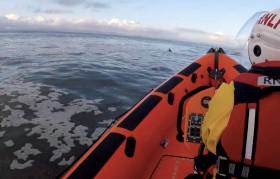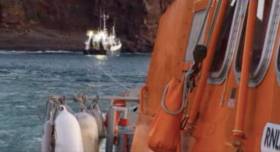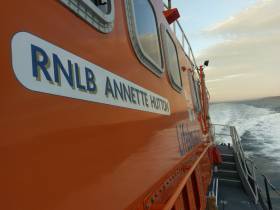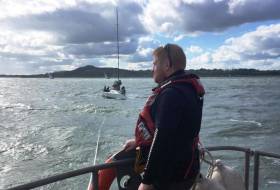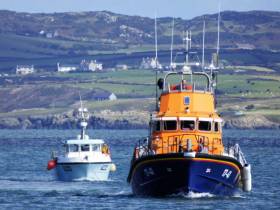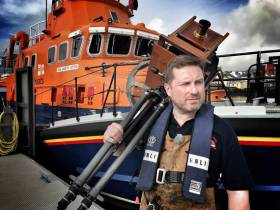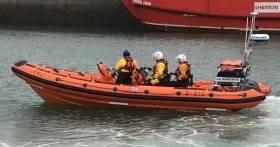Displaying items by tag: Lifeboats
Bundoran Lifeboat Helps Surfer Safely To Shore
#Lifeboats - Bundoran’s RNLI crew assisted a surfer safely to shore on Saturday afternoon (10 November).
The volunteers launched after a member of the public raised the alarm, having spotted someone they thought to be in difficulty and waving their arm off Rougey Point in Bundoran.
The Irish Coast Guard requested the inshore lifeboat to launch at 3.28pm and 10 minutes later the lifeboat, helmed by Killian O’Kelly, was at sea.
Weather conditions at the time were blowing a light south-easterly wind and there was a three-metre swell.
Once on scene, the lifeboat crew observed that the surfer, while not in difficulty or in any immediate danger, was in a challenging part of the sea and some distance away from the shore.
The crew made the decision to take the teenager onboard and transport him safely back to Bundoran Lifeboat Station.
Speaking following the callout, O’Kelly said: “We would like to commend the member of the public who raised the alarm this afternoon — that is always the right thing to do if you see someone you think or know to be in difficulty.
“While this surfer was not in any immediate danger, he was some distance from shore so we made a call to assist him safely back to shore.”
Elsewhere, a person who went missing while kitesurfing off Ballybunion in Co Clare yesterday evening (Sunday 11 November) was found on land several hours later, as RTÉ News reports.
The kitesurfer, who had come ashore at Kilkee, was said to be suffering the effects of cold after spending as much as two-and-a-half hours at sea and was taken to hospital.
Dunmore East Lifeboat In Early-Hours Rescue Of Five Fishermen After Trawler Runs Aground
#Lifeboats - Dunmore East RNLI’s all-weather lifeboat launched in the early hours of yesterday morning (Thursday 1 November) to a 23m fishing trawler that had run aground with five people onboard half a mile south-west of Dunmore East Harbour.
At 2.06am, the Dunmore East RNLI all-weather lifeboat launched on service to assist the fishermen.
Minutes after the launch, the Trent class lifeboat Windsor Runner arrived on scene to find the trawler high and dry on the rocky shoreline with an ebbing tide.
The five crew onboard the trawler were in no immediate danger, so it was decided to wait for the tide to rise again and then tow the vessel off the rocks.
Dunmore East’s lifeboat crew remained on scene and at 7am the trawler with five crew onboard was successfully towed away the rocks undamaged and was able to make its way under power to Dunmore East Harbour.
Escorted by Dunmore East RNLI’s lifeboat, they made the safety of the harbour at 7.20am.
Dunmore East RNLI coxswain Michael Griffin said: “The conditions on scene were good at the time and thankfully the trawler didn’t sustain any major damage.
“Credit to our volunteer crew who worked tirelessly during the early hours of this morning to ensure the success of the mission.”
At 16:15pm on Friday 19 October, Carrybridge RNLI’s inshore lifeboat, Douglas Euan & Kay Richards and Rescue Water Craft (RWC) launched following a request by Belfast Coastguard to assist a vessel with three persons on board which had run aground approximately 1 mile North of Knockninny Marina.
Winds were South Westerly, Force 2. Visibility was good with an overcast sky.
The lifeboat and RWC arrived with the casualty vessel and once on board assessed the vessel for water ingress and none was found.
The volunteer crew successfully refloated the vessel and towed it to deeper water. The boat was again assessed for water ingress, and its propulsion and steering tested. The vessel was found to be ok.
The lifeboat and RWC escorted the vessel for a time as it made its onward journey, after which the crew departed and made their way back to the station arriving at 17:45pm.
Speaking following the call out, Stephen Scott, Deputy Launching Authority at Carrybridge RNLI said: ‘Boat users should be mindful of shallow sections of water and always keep to the main navigation channels. All water users should wear a lifejacket and always carry a means of communication for help. The number to dial should you find yourself in trouble is: 999 or 112 and ask for the Coastguard.’
#Lifeboats - Castletownbere’s all-weather lifeboat launched last night (Wednesday 10 October) to a Mayday from six fisherman whose boat lost power and was drifting rapidly towards the shore.
Pagers sounded for the volunteer RNLI crew at 7.30pm following the alert to the Irish Coast Guard from the 25m fishing boat, which had fouled its propeller at the entrance to the West Cork harbour.
With time of the essence, coxswain Dean Hegarty and his four crew launched immediately and the lifeboat was on scene within five minutes, at which point the vessel was just 20 metres from the shore.
The boat had been blown into a small area by Pipers Rock at the harbour mouth in south-westerly Force 8-9 gales and amid a 4-5m swell.
The lifeboat crew worked quickly to set up a towline and rescue the boat and her crew from immediate danger before bringing them safely back to Castletownbere.
“Given the weather conditions and how close the fishing boat was drifting to the shore at this point, the lifeboat’s timely arrival managed to avert a potential tragedy,” said Paul Stevens, Castletownbere RNLI lifeboat operations manager.
“The fishermen did the right thing in raising the alarm when they did and we would like to wish them well following what must have been a challenging experience.”
Arklow Lifeboat Rescues Four In Busy Early October Weekend
#Lifeboats - Arklow’s volunteer RNLI crew rescued four people in two separate callouts over the weekend.
The first launch was on Saturday afternoon (6 October) to a yacht which had gotten into difficulty and was without power about one mile east of Arklow harbour.
Three crew and their vessel were towed safely back to Arklow.
The second callout came in the early hours of Sunday morning (7 October) when the Arklow lifeboat launched at 2.30am to a report of a person in the water in the harbour.
Thanks to witnesses on scene as well as local gardaí and coastguard officers, the casualty was located and thrown a life ring to keep them afloat till the lifeboat arrived minutes later.
Once out of the water, the casualty was taken to hospital by ambulance.
“We would like to extend our thanks to the members of the public who alerted the coastguard and the local gardaí to this incident,” said Mark Corcoran, community safety officer at Arklow RNLI.
“Without this early call for help and assistance during the rescue, this callout could have ended very differently.”
Arklow RNLI reminds the public to people to respect the water – always wear a lifejacket and to carry a means of calling for help when going out on or near the water.
Baltimore RNLI To Lay Wreath On Centenary Of Thomas Joseph Wreck
Next Wednesday evening (10 October), Baltimore RNLI's volunteer lifeboat crew will lay a wreath at the Catalogues to commemorate the centenary of the wreck of the Thomas Joseph.
The 60ft lugger was wrecked on the Catalogue Rocks between Sherkin Island and the mainland. Six people, including owner and captain John Daly, lost their lives in the tragedy, with five rescued.
The fishing boat had just been fitted with a new Parsons marine engine, but 100 years later it is still not known whether that was a contributing factor to the Thomas Joseph’s loss.
What is understood is that within 10 minutes of Baltimore on voyage to nearby Schull, disaster occurred.
Baltimore RNLI’s Facebook page has much more on the story HERE.
Irish Fishing Vessel Rescued By Holyhead Lifeboat
#Lifeboats - Holyhead’s all-weather lifeboat launched yesterday morning (Saturday 29 September) to the rescue of an Irish fishing boat adrift in the Irish Sea with mechanical failure.
Pagers sounded for the Holyhead RNLI crew just after 8am following a distress call to HM Coastguard from the 10m potting vessel, which was some 21 miles northwest of Holyhead.
On reaching the stricken boat, the crew on the lifeboat Christopher Pearce set up a tow for the slow return to Holyhead. In all the lifeboat was five hours at sea.
Aafter ensuring all were well, the fishermen set off to return to Ireland on the next ferry, leaving their vessel to be repaired locally.
Holyhead coxswain Tony Price said: “The casualty craft and her crew were well-equipped. It’s always a shame for any craft or persons in difficulty, but it’s particularly sad when a vessel is earning her living from the sea, and we wish our Irish fishermen friends a speedy return to normality after their misfortune.
“I’d also like to send thanks to the local coastguard teams for helping with mooring the craft safely back in Holyhead.”
Photographer Reaches Halfway Mark On Epic Project To Capture Lifeboat Stations With Victorian Camera
#Lifeboats - After almost four years, Jack Lowe will this week reach the halfway point of his epic ambition to photograph all 238 stations in the RNLI network when he visits Dover Lifeboat Station.
Since he began The Lifeboat Station Project in January 2015, Lowe has photographed more than 2,000 lifeboat volunteers — and around a dozen dogs, who are often included if their owners are on the crew — using wet plate collodion, a Victorian process that creates stunning images on glass.
And he produces his work on the road in ‘Neena’, a decommissioned NHS ambulance he’s converted into a mobile darkroom.
By the time he reaches Dover this week, he will have been to 140 lifeboat stations and created images on over 1,500 glass plates.
Making his images has taken 120 litres of developer and 45 litres of collodion.
He’s also driven over 28,000 miles, which is more than once round the world, and used about 8,400 litres of fuel – and stayed at more than 100 B&Bs.
This major landmark comes as the RNLI has announced that Lowe’s work will feature in a major exhibition, Calm Before the Storm: The Art of Photographing Lifeboats, in 2019.
But it hasn’t all been plain sailing.
This time last year, Lowe’s tour took him to Ireland, where he photographed the volunteers crews at stations along the South Coast from Waterford to Kerry.
After Lowe had completed his 100th station — Valentia in Co Kerry — he revealed to his social media followers that he was struggling to keep going.
His struggles were physical, emotional — and financial, as the project is largely self-funded.
But thanks to the support of fans of his work via the crowdfunding platform Patreon, Lowe was able to continue the project on a surer footing.
“Ultimately, I’m honoured beyond words to be making this archive,” Lowe said. “It’s a privilege spending time with so many lifeboat volunteers, preserving their bravery and devotion for future generations.
“This journey is unprecedented in so many ways. The further I travel, the deeper the body of work becomes on just about every level and in ways that I could never have foreseen or imagined.”
The Lifeboat Station Project’s dedicated website has links to Lowe’s Facebook, Twitter and Instagram feeds, as well as his Patreon campaign.
Baltimore RNLI Welcomes Inshore Lifeboat On Service
#Lifeboats - Baltimore RNLI has welcomed its new Atlantic 85 class inshore lifeboat on service in the West Cork village.
The inshore lifeboat arrived at Baltimore lifeboat station on Thursday 13 September and replaces the Atlantic 75 class lifeboat, Patricia Jennings, which has been used to save lives at sea in Baltimore since 2016.
Last week saw the volunteer lifeboat crew undertake familiarisation training on the Rita Daphne Smyth, and the new inshore lifeboat officially went on service at Baltimore lifeboat station last Thursday evening (20 September) alongside the all-weather lifeboat Alan Massey.
The new lifeboat has been funded through a legacy from the late Rita Daphne Smyth, a native of Harrow in Middlesex, England, who was a supporter of the charity’s volunteers in saving lives at sea.
The Rita Daphne Smyth will be officially named at a special
ceremony and service of dedication.
In her two years in Baltimore, Patricia Jennings launched 21 times, with its volunteer lifeboat crew rescuing 17 people.
The new lifeboat has some advancement on its predecessor. The Atlantic 85 is 10m longer than the Atlantic 75 and allows room for four crew members onboard rather than three.
The lifeboat is powered by two 115hp engines and has a stronger hull and greater top speed of 35 knots. The added radar allows the crew to operate more effectively in poor visibility and there is also VHF direction-finding equipment.
The vessel has a manually operated self-righting mechanism which, combined with inversion-proofed engines, keeps the lifeboat operational even after capsize. The lifeboat can also be beached in an emergency without causing damage to its engines or steering gear.
The Atlantic 85, which was introduced to the RNLI fleet in 2005, also carries a full suite of communication and electronic navigation aids, as well as a searchlight, night-vision equipment and flares for night-time operations.
Baltimore RNLI lifeboat operations manager Tom Bushe said: “We are extremely grateful to Miss Smyth for the generous legacy donation which has funded our new lifeboat.
“As we welcome a new lifeboat, there is also a sense of nostalgia among us today too as we bid a fond farewell to Patricia Jennings who provided us with two great years of service.
“Patricia Jennings time here in Baltimore brought many people safely to shore and we hope her donor family will be just as proud as we are, of her many achievements.
“We are looking forward to being the custodians of this new lifeboat which will allow our volunteers to go on to rescue and save many more lives in the years to come.”
Weekend Callouts For Arklow & Skerries Lifeboats To Fishing Vessels In Difficulty
#Lifeboats - Arklow RNLI’s all-weather lifeboat crew left their Sunday lunch on 23 September to attend to a fishing vessel in difficulty east of Cahore Point in Co Wexford.
Once the vessel and its crew of three were located, it was established that while it had power, it could not make any headway due to its propeller being fouled with fishing gear.
The lifeboat volunteers rigged a tow line and set up for a long slow tow home to Arklow. All hands came ashore safely some five hours later.
Mark Corcoran, community safety officer at Arklow RNLI, said: “We would like to remind people to respect the water and always wear a lifejacket and carry a means of calling for help when going out on the water.”
The previous evening, Skerries RNLI was tasked to another fishing vessel which suffered mechanical failure and lost engine power less than half a mile north of Skerries harbour.
The struggling 22m fishing boat, with a crew of seven on board, was well lit and visible from the shore so the Atlantic 85 lifeboat Louis Simson made its way quickly alongside.
With the fishing vessel drifting dangerously close to the shore, it was decided to establish a tow to bring safely alongside the harbour.
Speaking about the callout, volunteer lifeboat press officer Gerry Canning said: “This was quite a large vessel for us to take under tow, but the conditions were very fair on the night and the Atlantic 85 was very much up to the job.”


























